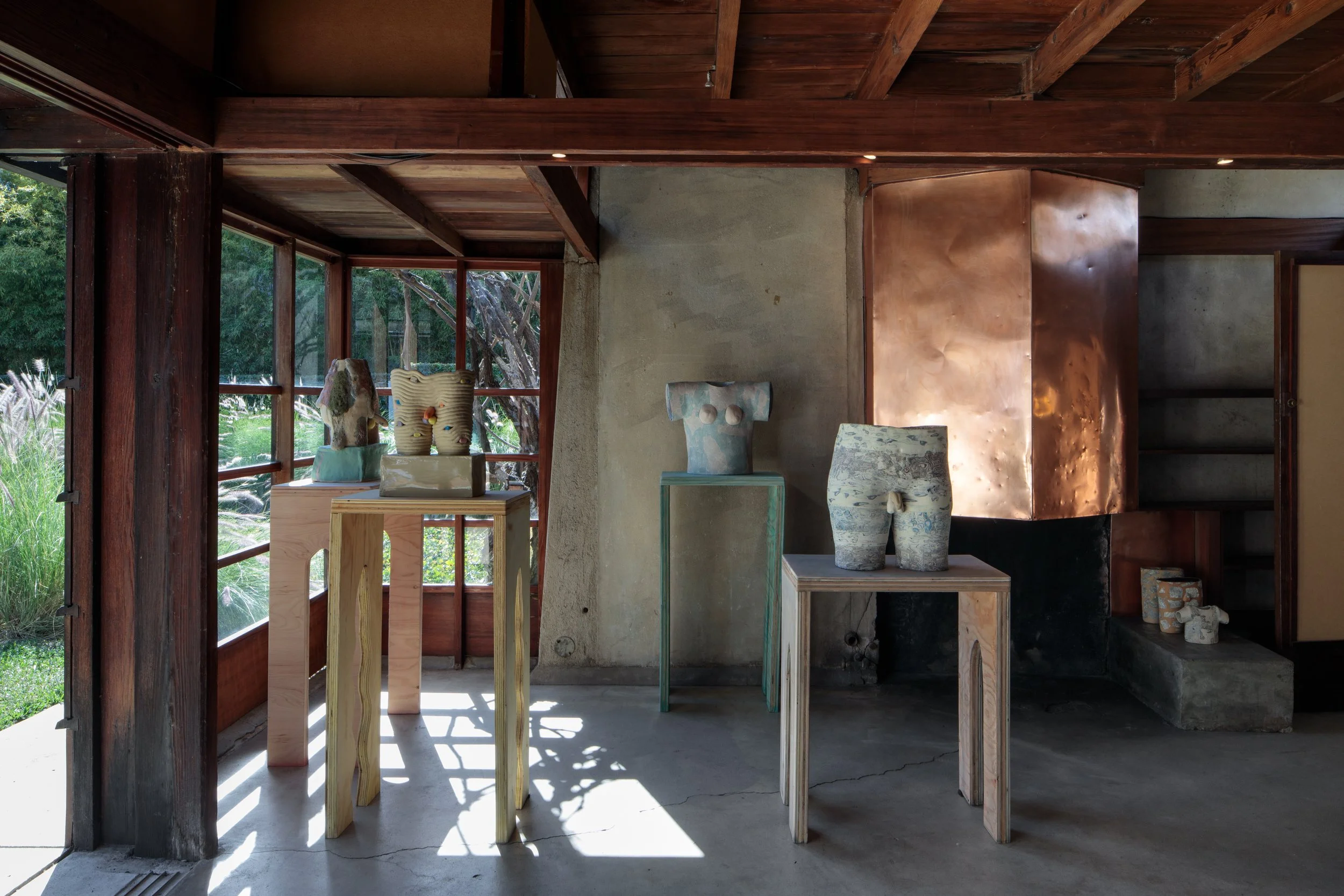Installation view of Soft Schindler. Photography by Taiyo Watanabe, 2019.
Soft Schindler, curated by Mimi Zeiger, begins with traces of pink paint on redwood—faint evidence of when in late 1949 Pauline Schindler, estranged from her architect husband but living in half of the house they built together, painted her side of the interior salmon pink. To R.M. Schindler, her intolerable act violated a sanctum of modernism and his desire for honest expression of natural materials. This exhibition, however, interprets her act as softening our canonical understanding of house as manifesto—softness as resistance—and yields to plural narratives that lay interpretive ground for contemporary artworks and architectural installations.
The Schindler House has never been a binary. “Both/and” to its core, the house contains nearly a century of fluid, alternating domesticities: dinner parties, political debates, and love affairs. It was the salon of art dealer Galka Scheyer and the stage for clashes with architect Richard Neutra. Archival photographs suggest material legacies in dialogue with Schindler’s rigorous geometries: tablecloths, pillows, curtains, flower pots—ephemeral elements that like the pink paint were not preserved when the residence was restored in the 1990s in approximation of the original intentions of the architect.
Soft Schindler participants, through their respective practices and presented works, show the incompleteness of binary ideas in architecture, sculpture, and design— femininity vs. masculinity, inside vs. outside, heavy vs. light, rational vs. emotional—framing such notions outmoded. Each of these practitioners makes non-conforming aesthetics and ideologies manifest in space.
Several challenge the architectural context with textiles and ceramics; works that foreground questions of bodies and gender. Grounded in feminist practices, Bryony Roberts Studio’s woven objects are designed to be squeezed, and suspended rope scuptures by Tanya Aguiñiga evoke precarity and disembodiment with their hammocked biomorphic forms. Bettina Hubby’s collages use humor to make strange the subject/object relationship, so that pillows and footstools remind us that relaxation is hard. Alice Lang’s ceramic expressively glazed torsos and bust undermine masculine dominance, while nine vessels by architects Leong Leong house an experiment in fermentation—a four-month long process that makes flabby even the sturdiest vegetables.
Other works expand upon social dynamics embodied in the Kings Road House. A curtain installation by AgendA agencia de arquitectura draws on the Schindlers’ early years of hosting bohemian gatherings as a couple; Sonja Gerdes transforms what used to be the nursery into a meditative and strange sanctuary; Design, Bitches occupy the space of the clerestory windows with words and phrases that echo the Schindler’s estrangement, and Anna Puigjaner’s drawings identify the shared kitchen as a point of domestic exchange and contestation.
Jorge Otero-Pailos’ latex castings of choreographer Merce Cunningham’s dance studio and sound collages problematize our interpretation of time, place, and memory by capturing what seems immaterial—dust and the residue of decades of dancers—and transfers the details of one iconic room to another. Placed in the Kings Road House, the two works amplify alternative histories, specifically John Cage’s connection to Pauline, a brief love affair that predated his personal and collaborative relationship with Cunningham.
The idea of “both/and” raises questions of mirroring and doubling as a function of softness. Two works, a diptych video by Pedro Alonso and Hugo Palmarola and the costumes/drawings by Laurel Consuelo Broughton, suggest that this is a condition that goes beyond the confines of the domestic realm. The twin videos pair U.S. and Soviet cartoons, evoking both Pauline’s left-wing and Communist leanings and positing a dialogue that takes place across time and nation state. In designing mascots for a future Los Angeles, Broughton reframes the urban realm as a site of fantasy over reality, performance over efficiency.
Ultimately, Soft Schindler uses the concept of softness to encourage a politics of re-evaluation: If this space/sculpture/material isn’t what was first assumed, what other assumptions need challenging?
Related events
Sat, Oct 12, 2019
6-8 pm
Sat, Feb 15, 2020
3-5 pm
This exhibition is made possible by the generous support of the Graham Foundation for Advanced Studies in the Fine Arts, Pasadena Art Alliance, Columbia GSAPP, and SCI-Arc.







